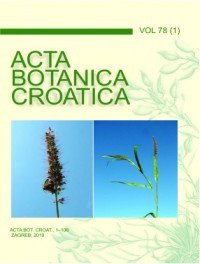Acta Botanica Croatica Q3 Unclaimed
Acta Botanica Croatica is a journal indexed in SJR in Plant Science and Ecology, Evolution, Behavior and Systematics with an H index of 30. It is an CC BY-NC-ND Journal with a Single blind Peer Review review system The scope of the journal is focused on terrestrial botany, aquatic botany, algal taxonomy, plant taxonomy. It has an SJR impact factor of 0,318 and it has a best quartile of Q3. It is published in English. It has an SJR impact factor of 0,318.
Type: Journal
Type of Copyright: CC BY-NC-ND
Languages: English
Open Access Policy: Open Access
Type of publications:
Publication frecuency: -
- €
Inmediate OANPD
Embargoed OA- €
Non OAMetrics
0,318
SJR Impact factor30
H Index19
Total Docs (Last Year)82
Total Docs (3 years)668
Total Refs108
Total Cites (3 years)81
Citable Docs (3 years)1.04
Cites/Doc (2 years)35.16
Ref/DocOther journals with similar parameters
Acta Botanica Brasilica Q3
Grana Q3
Candollea Q3
Chinese Journal of Plant Ecology Q3
Turczaninowia Q3
Compare this journals
Aims and Scope
Best articles by citations
Heat tolerance indicators in Pakistani wheat (Triticum aestivum L.) genotypes
View moreAquatic Plant Trapa natans L. as Bioindicator of Trace Metal Contamination in a Freshwater Lake (Skadar Lake, Montenegro)
View moreFirst Italian record of Paspalum notatum Flugge (Poaceae) and its typification
View moreHalophilic diatom taxa are sensitive indicators of even short term changes in lowland lotic systems
View moreEffects of Biodynamic Production on Growth and Essential Oil Content in Basil
View moreBotrychium matricariifolium, a new fern species for the flora of Montenegro
View moreAlien water lettuce (Pistia stratiotes L.) outcompeted native macrophytes and altered the ecological conditions of a Sava oxbow lake (SE Slovenia)
View moreComparative analysis of specialized metabolites and antioxidant capacity in vitro of different natural populations of Globularia spp.
View morePhysiological responses of crop plants against Trichoderma harzianum in saline environment
View moreAlyssum desertorum Stapf (Brassicaceae), new for the Italian flora
View moreNew xenophytes from the Canary Islands (Gran Canaria and Tenerife; Spain)
View morePhysiological responses of peanut (Arachis hypogaea L.) cultivars to water deficit stress: status of oxidative stress and antioxidant enzyme activities
View moreEchinochloa colona (L.) Link (Poaceae), a new species in the flora of Croatia
View morePhysiological responses of two halophytic grass species under drought stress environment
View moreDiatom communities and vegetation of springs in the south-western Alps
View moreAn Eco-physiological and Biotechnological Approach to Conservation of the World-wide Rare and Endangered Aquatic Liverwort Riella helicophylla (Bory et Mont.) Mont.
View moreEpilithic diatom assemblages and environmental quality of the Su Gologone karst spring (centraleastern Sardinia, Italy)
View moreIs drought altering plant populations in the mountainous region of Northeastern Mexico?
View moreTwo moss species from Mt Durmitor new to the bryophyte flora of Montenegro
View moreThe first report on periphytic diatoms on artificial and natural substrate in the karstic spring Bunica, Bosnia and Herzegovina
View moreDiversity and gradients of vegetation of Sivrihisar Mountains (Eskisehir-Turkey)
View moreGoniolimon dalmaticum Rchb. f. and G. tataricum (L.) Boiss. (Plumbaginaceae) in the Croatian Flora and their Distribution in the Balkan Peninsula
View moreImpact of nickel on grapevine (Vitis vinifera L.) root plasma membrane, ROS generation, and cell viability
View moreApplied use of taxonomy: lessons learned from the first German intercalibration exercise for benthic diatoms
View more




Comments